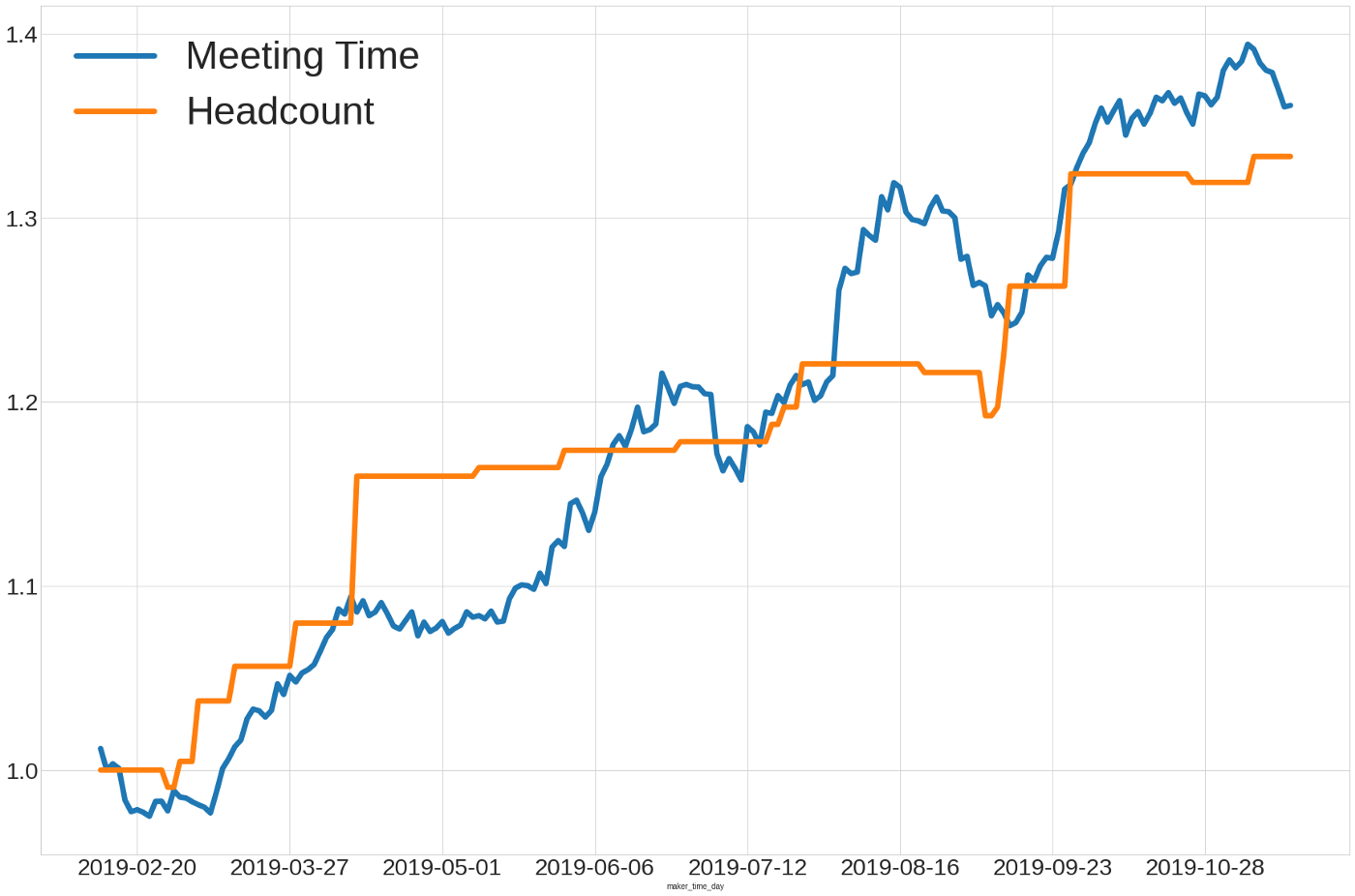Too often, engineering leaders focus on output metrics of productivity — the most infamous one being lines of code. Conversely, input metrics are more actionable, harder to game, and higher leverage. As Bill Walsh, one of the most well-regarded NFL coaches, once said:
Concentrate on what will produce results rather than on the results, the process rather than the prize
In a similar way, The State of DevOps study of 31,000 engineering professionals goes as far as defining productivity itself as the ability to get complex, time-consuming tasks completed with minimal distractions and interruptions — a pure input metric which is essentially the inverse of time spent in meetings or waiting for the next meeting.
At Okay, we therefore believe that any engineering leader should gain intimate knowledge of their team's time, especially as the company grows. To that end, it can be helpful to know a couple "meeting constants" that are likely to be at play in any team. Drawing inspiration from the famous Latency Numbers Every Programmer Should Know, we analyzed the calendars of 350 engineers in Silicon Valley in the past 18 months. Here are the results.
Preamble: some basic meeting math
Before we dive into the data, it's helpful to remember 2 key aspects of meetings
1/ Meetings ~ O(headcount²)
Meetings exist because of the need to coordinate activities between individuals. In that sense, any possible pairwise interaction in your company is a meeting waiting to happen. By nature, managers find themselves at the core of these interactions, because their role is precisely to lead and coordinate. A well-designed organization will streamline communication channels, but in practice, it is safe to assume that meeting load will grow quadratically with the size of your organization.
The faster you grow, the higher the risk of bloating your organization with meetings
2/ Time is money, or the $350 standup
The raw cost of a meeting is:
NbAttendees X AverageSalary (attendees) X Meeting Length
Assuming the $150k average salary of engineers in the Bay Area and 20% overhead, the 30min standup your 8-people team is having every morning costs about $350. Another way to look at it is: you are spending the equivalent of half-an-engineer to have this meeting.
Always bring meetings back to what they are: coordination costs, and be clear about their ROI
55% of engineers' time is meeting-related
On average, we found that 45% of an average engineer's day consists of uninterrupted blocks of productive time, also called Maker Time. The rest of the time is used for meetings or what we call friction time, which are gaps of less than 2 hours in-between meetings — not long enough to go back into the flow.
The top managers in our study are able to get Maker Time to 70%, or conversely meeting-related time down to 30%. These teams have about 70/45 ~1.5x higher output than the average team. Engineers also report higher satisfaction than engineers on the average team.
Take-aways:
- It is safe to assume that the real bandwidth of the typical engineering team is about half of what you'd expect
- Top teams have about 70% Maker Time by adopting better time management practices and healthier meeting hygiene.
60% of meetings are recurring
When you look at the typical meeting list of an engineer (stand-ups, 1/1s, retrospectives, design meetings, office hours, etc.), about 60% of these meetings are recurring.
Referring back to the meeting cost formula, recurring meetings ensure that you will spend the equivalent team time in perpetuity :) They put an upper bound on the raw productivity of your team.
Take-aways:
- If you are looking for productivity gains, start by reevaluating your recurring meetings. On larger teams, we have seen leaders gain back the equivalent of 2 to 3 engineers by re-structuring recurring meetings.
- Audit recurring meetings at least once a month and aggressively remove the ones that don't pass your ROI bar.
- Refrain from creating recurring meetings. If you have to have them, always give them an expiration date. It will force you to re-evaluate their benefit.
Meetings WILL fill up your team's calendar as you grow
Zooming into our sample, we looked at a group of 165 engineers belonging to fast-growing companies over the past year. This is a comparison of the relative growth of headcount and the relative growth of meeting time per individual.

As you can see, increases in headcount are a leading indicator of increases in meeting time —ie a step increase in headcount is followed by a gradual increase of meeting time a couple weeks later. This is likely due to the quadratic law we mentioned above, as well as the cost of onboarding and training new hires, which usually happens through meetings.
Take-aways:
- If you do nothing, meetings will win. Your culture will predictably trends towards big-company culture.
- As a leader, you should pro-actively counter-balance the effects of increased coordination. You can do this by setting guidelines on meeting hygiene and developing asynchronous means of coordination.
- The most effective way to scale is by setting budgets on meeting time and track them like any other budget.
You now know the meeting numbers that are probably affecting your team. We encourage you to measure and verify if this actually applies to your engineers. Please shoot us a note if not! We'd love to learn and refine our dataset.
As a final take-away:
- Meetings are a key input to your team's productivity
- You should feel responsible and accountable for managing this input to goals that YOU decide.
- Taking control of meetings will not only improve productivity, but it will also help you lead happier teams!
— Okay founders
